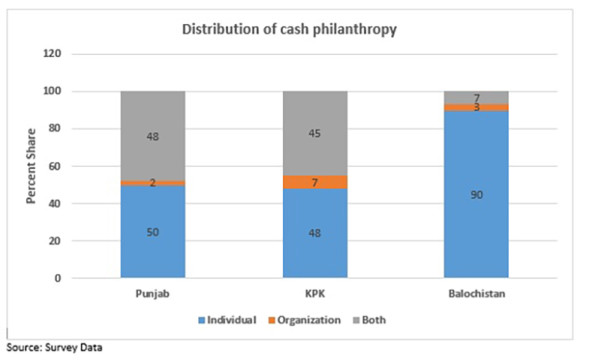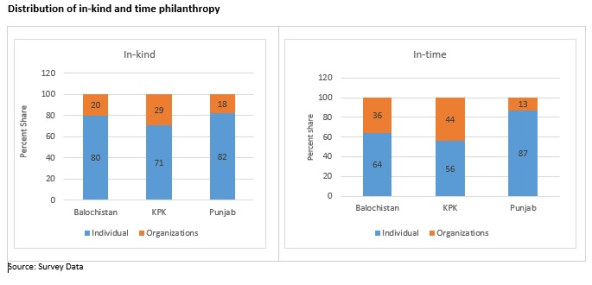When it comes to charitable giving, Pakistan is a generous country. It contributes more than one percent of its GDP to charity, which pushes it into the ranks of far wealthier countries like the United Kingdom (1.3 percent GDP to charity) and Canada (1.2 percent of GDP), and around twice what India gives relative to GDP. A study conducted by Pakistan Centre for Philanthropy shows that Pakistanis give around PKR 240 billion (more than $2 billion) annually to charity. The same report indicates that about 98 percent of people in the country give in one form or another—if not with cash, then with in-kind donations or by volunteering for needy causes.
Fueling this culture of generosity is the Islamic emphasis on giving—in the form of Zakat, Sadaqa, and Fitrana—as well as other moral and social factors and a deeply rooted sense of compassion toward community members.
But despite this tradition of giving, most donations go directly to individuals, thus bypassing charitable organizations. While supporting needy individuals plays an integral role in Pakistan’s social safety net, to realize the full impact of philanthropy for more sustained development efforts, we must do more. For Pakistan to become a more integral player in the sustainable development agenda, we need to make efforts to institutionalize the individual tendency of giving and redirect it toward more-structured efforts. Thus, understanding the dynamics behind this preference of individual vs. organization is essential to building a truly civil and sustainable future.
In trying to understand why Pakistanis prefer giving to individuals instead of organizations, we conducted research via household surveys and focus group discussions. We measured philanthropy in three ways: monetary giving, in-kind giving, and time volunteered. We found that when accounting for all forms of philanthropy, 67 percent of survey respondents said they give to individuals while 33 percent of respondents preferred giving to organizations.
Are you enjoying this article? Read more like this, plus SSIR's full archive of content, when you subscribe.
Regional differences in giving trends
We collected data in the Sindh province in 2013 and also in Punjab, Balochistan, and Khyber Pakhtunkhwa (KPK) in 2014. In the case of in-cash philanthropy, Balochistan stands out with 90 percent of respondents preferring individuals as recipients for their giving. One reason for this could be that Baluchistan is the least developed province of the ones we studied, and thus charitable organizations in Baluchistan are less established and have gained less public trust that ones in the more developed provinces.
 Distribution of cash philanthropy: organizations vs. individuals.
Distribution of cash philanthropy: organizations vs. individuals.
Similar to cash donations, donors also prefer individuals for in-kind giving and time volunteered, albeit to a lesser extent. Punjab and Balochistan give in-kind donations to individuals at almost equal rates, and both provinces give slightly more than KPK does. Organizations seem to fare much better, however, when it comes to time spent volunteering: In KPK, close to half of the respondents volunteered their time for organizations, followed by Balochistan, with more than one-third of the respondents volunteering their time for organizations.
 Distribution of in-kind and time philanthropy: organizations vs. individuals.
Distribution of in-kind and time philanthropy: organizations vs. individuals.
According to our research, there are four major reasons Pakistanis prefer giving to individuals over socially minded organizations:
1. Compassion spurs in-the-moment giving.
Cash donations are most frequently made in small amounts and on a regular basis. Needy individuals are the prime beneficiaries of this type of donation, as they inspire spontaneous giving driven by compassion in the moment. These individuals are also easily accessible, while organizations require more planning on the part of the donor. In addition, many organizations have not yet developed the requisite infrastructure to collect small donations.
2. Religious institutions are set up to collect small donations.
Religious institutions such as mosques and madrassahs likely get the bulk of giving that goes to organizations. These institutions also have infrastructure in place geared toward collecting small donations, in the form of door-to-door campaigns, donation boxes placed at counters of shopping outlets, and so on. Through such efforts, they are highly visible to potential donors.
3. Lack of trust in charitable organizations.
Fear of misuse, wastefulness, and lack of impact play an important role in discouraging people from donating to organizations. Proximity and reputation are the two main factors that encourage people to donate to any one organization. Mosques and madrassahs are more trusted than civil society organizations, hence they receive the lion’s share of donations that flow to organizations.
4. Wealth plays a role in giving to organizations.
While wealth does not seem to influence giving exclusively to organizations, we found that wealth positively influenced the giving priorities of people who responded as giving to both individuals and organizations. In other words, the higher the level of wealth, the more inclination toward giving to both individuals and organizations (and vice versa). One reason for this could be that people in lower income groups have closer ties with needy individuals, while they may have less familiarity with charitable organizations. People with high incomes often have direct connections with foundations and other charitable organizations. In Balochistan, where more people fall in low- and middle-income groups as compared to KPK and Punjab, around 90 percent of philanthropy goes to individuals.
There is no doubt that Pakistanis are a generous people, as the practice of giving is nearly universal. However, this charitable impulse needs to target more impact-oriented philanthropy. In this way, individual donations can play a more-effective role in inclusive development than simply assuaging the symptoms of poverty. It is evident that a lack of trust for civil society organizations is hampering their fundraising efforts. To encourage more institutional giving, organizations have to ensure transparency and accountability, thereby mitigating the trust deficit of givers. While civil society organizations need to expand their fundraising networks among the general public, efforts should also be made to inform people that giving to organizations may have greater impact than giving to individuals.
Support SSIR’s coverage of cross-sector solutions to global challenges.
Help us further the reach of innovative ideas. Donate today.
Read more stories by Shazia M. Amjad & Muhammad Ali.

